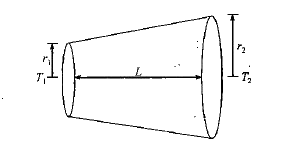Complete Solutions to Practice Exercise 4.1 of chapter HEAT TRANSFER of Class 12 book with complete answers and questions
| Class 12 | PHYSICS |
| Chapter | HEAT TRANSFER |
| PHYSICS GALAXY | Practice Exercise 4.1 |
| Number Of Questions | 11 |
| Academic Year | 2023-24 |
A wall has two layers A and B, each made of different material. Both the layers have the same thickness. The thermal conductivity of the material of A is twice that of B . Under thermal equilibrium, the temperature difference across the wall is `36^@C.` The temperature difference across the layer A is
View SolutionA 100 W heater is placed in a cubical container of edge length `6xx10^(-2)m.` The wall thick ness of the container is 1 mm. If inside and outside temperature in steady state are `30^(@)C.` and `25^(@)C,` find the thermal conductivity of the material of the box.
View SolutionOne end of a copper rod of length 1.0 m and area of cross-section `10^(-3)` is immersed in boiling water and the other end in ice. If the coefficient of thermal conductivity of copper is `92 cal//m-s-.^(@)C` and the latent heat of ice is `8xx 10^(4) cal//kg`, then the amount of ice which will melt in one minute is
View SolutionWater is filled in a closed cylindrical vessel of 10 cm height and base radius `sqrt(10//pi)` cm. The open ends ofthe cylinder are closed by two metal discs made ofa material whose thickness is `10^(-3)m` and having thermal conductivity `200W//m^(@)C.` If water temperature inside the cylinder is `50^(@)C` and surrounding temperature is `20^(@)C,` findthe time taken for the temperature to fall by `1^(@)C,` Given that the specific heat ofwater is `4200J//kg^(@)C.` and heat loss from water only takes place by the discs as the walls are made up of a thermally insulating material.
View SolutionA uniform steel rod of length 50 cm is insulated on its sides. There is a layer of water of thick ness 0.2 mm at each end of the rod. If the ends of the rod are exposed to ice at `0^(@)C`, and steam at `100^(@)C,` calculate the temperature gradient in the rod. Thermal conductivities of steel and water are `0.11calcm^(-1)s^(-1)``""^(@)C^(-1) and 1.5xx10^(-3)calcm^(-1)s^(-1)``""^(@)C^(-1)`
View SolutionTwo plates ofthe same area and the same thickness having thermal conductivities `k_(1)` and `k_(2)` are placed one on top of the other. Show that the thermal conductivity of the composite plate for conduction of heat is given by
`k=(2k_(1)k_(2))/((k_(1)+k_(2))`
View SolutionFigure shows water in a container having `2.0mm` thick walls made of a material of thermal conductivity `0.50Wm^(-1).^(@)C^(-1)` . The container is kept in a melting-ice bath at `0^(@)C` . The total surface area in contact with water is `0.05m^(2)` . A wheel is clamped inside the water and is coupled to a block of mass M as shown in the figure. As the block goes down, the wheel rotates. It is found that after some time a steady state is reached in which the block goes down with a constant speed of `10cm^(-1)` and the temperature of the water remains constant at `1.0^(@)C` .Find the mass `M` of the block. Assume that the heat flow out of the water only through the walls in contact. Take `g=10ms^(-2)` .

View SolutionFind the heat current through the frustum of a cone shown in figure-4.20. Temperature of its two ends are maintained at `T_(1)` and `T_(2)`(T_(2)>T_(1))` respectively and the thermal conductivity of the material is k.

View SolutionThree rods of identical cross-sectional area and made from the same metal form the sides of an isosceles triangle ABC right angled at B as shown in the figure. The points A and B are maintained at temperature T and `(sqrt2)T` respectively in the steady state. Assuming that only heat conduction takes place, temperature of point C will be

View SolutionTwo identical rods AB and CD, each of length L are connected as shown in figure-4.22. Their cross-sectional area is A and their thermal conductivity is k. Ends A, C and D are maintained at temperatures `T_(1),T_(2) and T_(3)` respectively. Neglecting heat loss to the surroundings, find the temperature at B.

View SolutionA room at `20^@C` is heated by a heater of resistence 20 ohm connected to 200 VV mains. The temperature is uniform throughout the room and the heati s transmitted through a glass window of area `1m^2` and thickness 0.2 cm. Calculate the temperature outside. Thermal conductivity of glass is `0.2 cal//mC^@` s and mechanical equivalent of heat is `4.2 J//cal`.
View Solution
Practice Exercise 4.1 questions and complete solutions for chapter HEAT TRANSFER of GK PUBLICATIONS PHYSICS (HINGLISH) of Class 12
All Exercises from PHYSICS GALAXY Class 12 PHYSICS HEAT TRANSFER
- Advance MCQs with One or More Option Correct
- Conceptual MCQs Single Option Correct
- Discussion Question
- Illustrative Example 4.1
- Illustrative Example 4.10
- Illustrative Example 4.11
- Illustrative Example 4.12
- Illustrative Example 4.13
- Illustrative Example 4.14
- Illustrative Example 4.15
- Illustrative Example 4.16
- Illustrative Example 4.17
- Illustrative Example 4.18
- Illustrative Example 4.19
- Illustrative Example 4.2
- Illustrative Example 4.20
- Illustrative Example 4.21
- Illustrative Example 4.22
- Illustrative Example 4.23
- Illustrative Example 4.24
- Illustrative Example 4.25
- Illustrative Example 4.26
- Illustrative Example 4.27
- Illustrative Example 4.28
- Illustrative Example 4.29
- Illustrative Example 4.3
- Illustrative Example 4.4
- Illustrative Example 4.5
- Illustrative Example 4.6
- Illustrative Example 4.7
- Illustrative Example 4.8
- Illustrative Example 4.9
- Numerical MCQs Single Options Correct
- Practice Exercise 4.1
- Practice Exercise 4.2
- Practice Exercise 4.3
- Practice Exercise 4.4
- Unsolved Numerical Problems for Preparation of NSEP,INPhO&IPhO